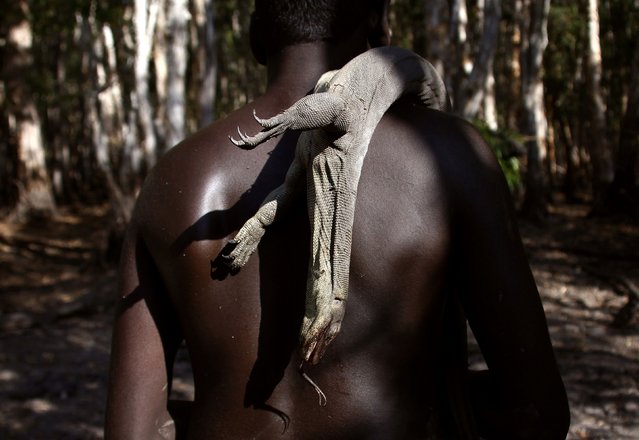
Australian Aboriginal hunter Marcus Gaykamangu of the Yolngu people, carries an Australian native lizard called a goanna over his shoulder as he walks away from a billabong near the “out station” of Yathalamarra, located on the outksirts of the community of Ramingining in East Arnhem Land November 22, 2014. The Arnhem Land reserve, closer to Bali than Sydney, covers an area of around 97,000 sq kms (37,000 sq miles), has a population of around 16,000 and access for non-Aborigines is by invitation only. Australia's aborigines are the custodians of the longest unbroken cultural tradition on earth, having migrated Down Under from Africa via Asia between 40,000 and 60,000 years ago, and connection to the land is practically written into their DNA. (Photo by David Gray/Reuters)
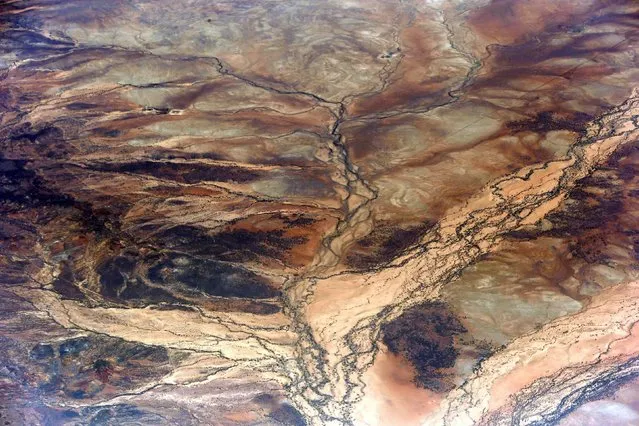
An aerial view of a river system in Australia's Northern Territory November 23, 2014. (Photo by David Gray/Reuters)
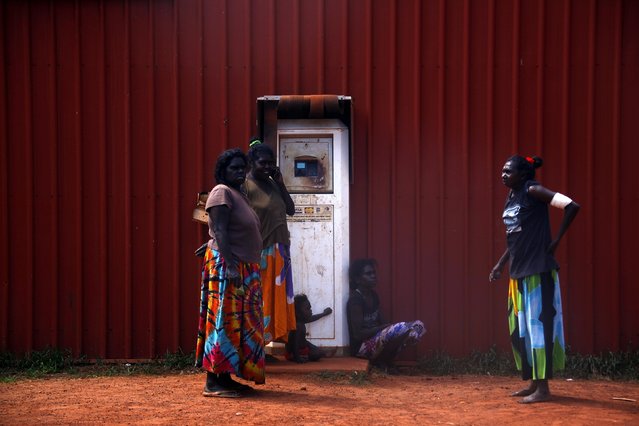
Members of the Australian Aboriginal community of Ramingining stand next to a machine used to pay for fuel in East Arnhem Land November 25, 2014. (Photo by David Gray/Reuters)
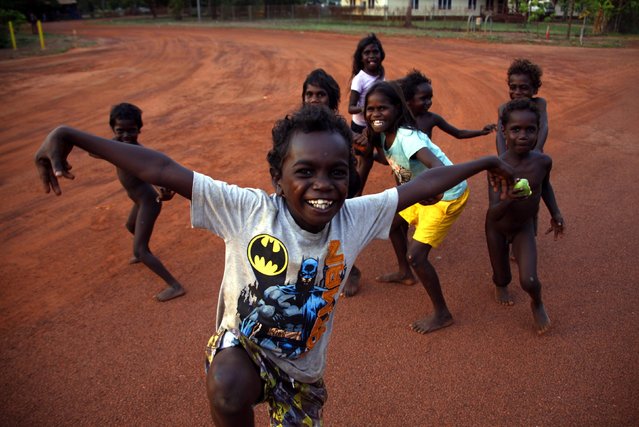
Australian Aboriginal children play on the dirt road that is the main street in the community of Ramingining in East Arnhem Land November 24, 2014. (Photo by David Gray/Reuters)
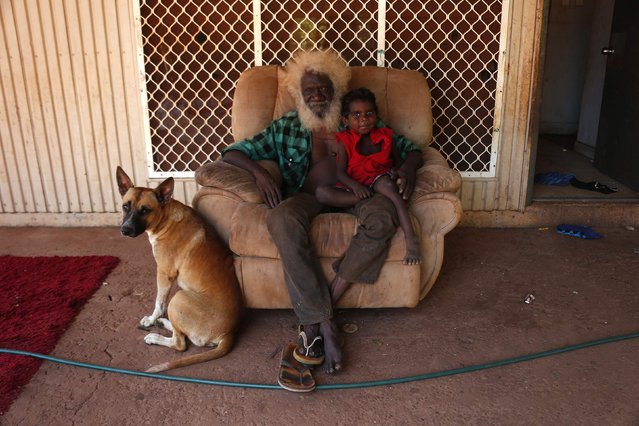
Robin Mildjingi and his grandson Gasier of the Yolngu people pose for a photograph as they sit out the front of their house in the Australian Aboriginal community of Ramingining located in East Arnhem Land November 21, 2014. (Photo by David Gray/Reuters)
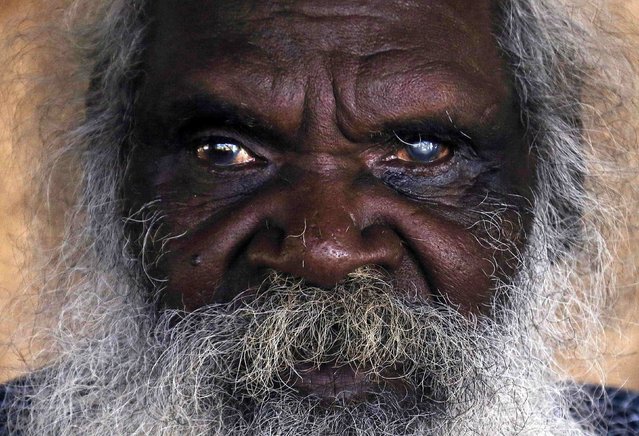
Seventy-six-year-old Australian Aboriginal elder Jimmy Burnyila of the Yolngu people sits at his house located on the outskirts of the community of Ramingining located in East Arnhem Land November 21, 2014. (Photo by David Gray/Reuters)
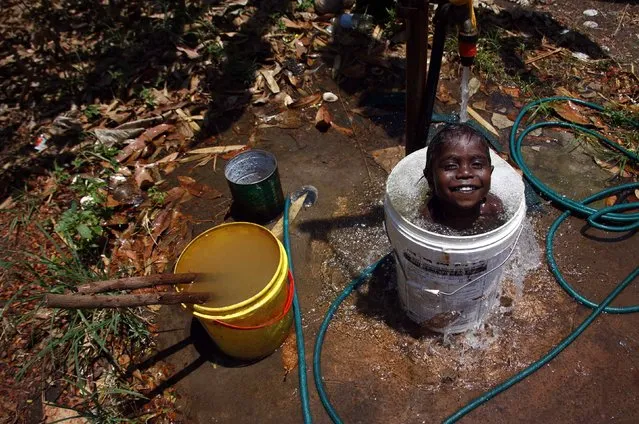
Four-year-old Gregory, grandson of Australian Aboriginal hunter Robert Gaykamangu of the Yolngu people, takes a bath in an old insecticide container at the “out station” of Ngangalala, located on the outksirts of the community of Ramingining in East Arnhem Land November 23, 2014. (Photo by David Gray/Reuters)
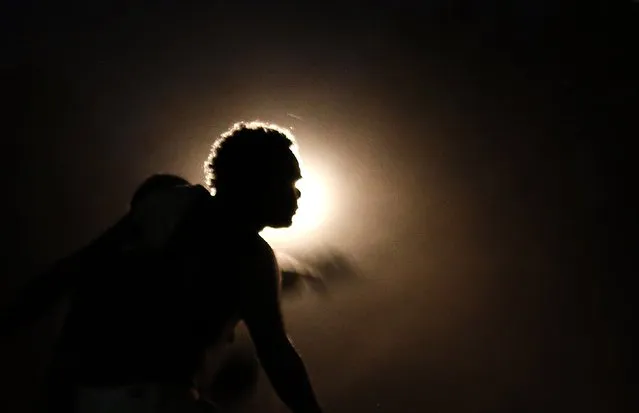
An Australian Aboriginal of the Yolngu people dances as he participates in an initiation ceremony at the “out station” of Yathalamarra, located on the outksirts of the community of Ramingining in East Arnhem Land November 21, 2014. (Photo by David Gray/Reuters)

Australian Aboriginals of the Yolngu people dance during an initiation ceremony at the “out station” of Yathalamarra, located on the outksirts of the community of Ramingining in East Arnhem Land November 21, 2014. (Photo by David Gray/Reuters)
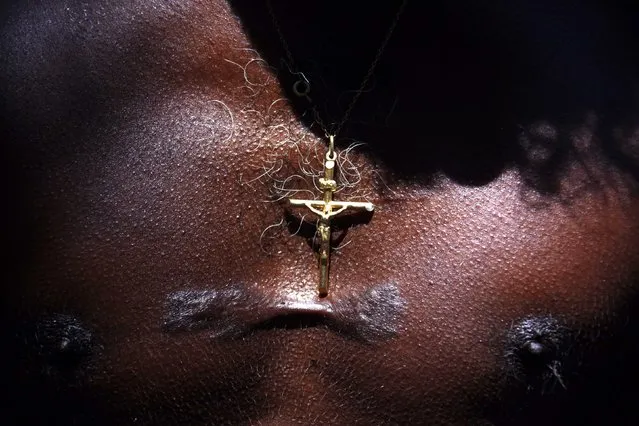
Australian Aboriginal hunter Bruce Gaykamangu of the Yolngu people wears a crucifix that sits just above his initiation scar while searching for Magpie Geese near the community of Ramingining in East Arnhem Land November 25, 2014. (Photo by David Gray/Reuters)
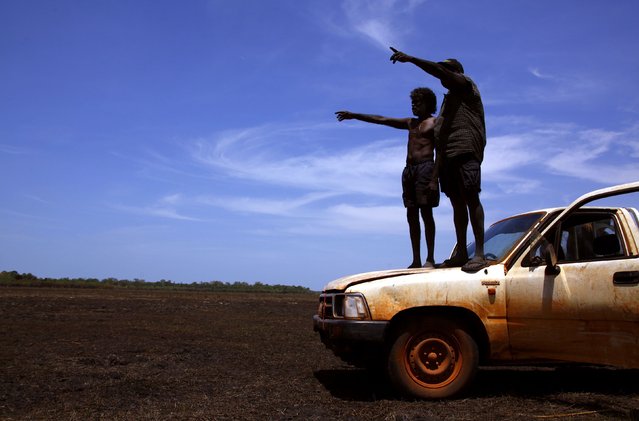
Australian Aboriginal hunters Bruce (L) and Robert Gaykamangu of the Yolngu people stand on the bonnet of their car looking for potential prey at a billabong near the “out station” of Ngangalala, located on the outksirts of the community of Ramingining in East Arnhem Land November 23, 2014. (Photo by David Gray/Reuters)
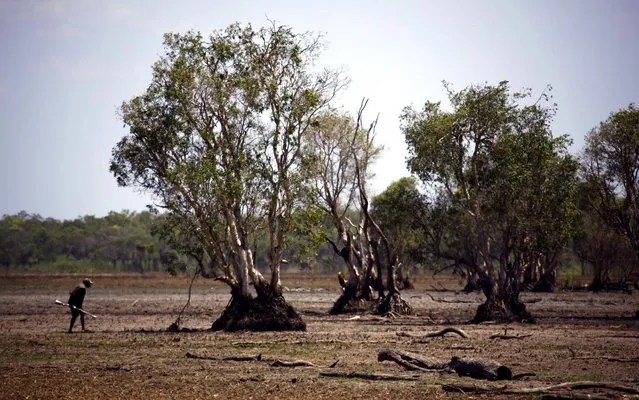
Australian Aboriginal hunter Robert Gaykamangu carries a shotgun to hunt Magpie Geese in a billabong near the “out station” of Ngangalala, located on the outksirts of the community of Ramingining in East Arnhem Land November 23, 2014. (Photo by David Gray/Reuters)
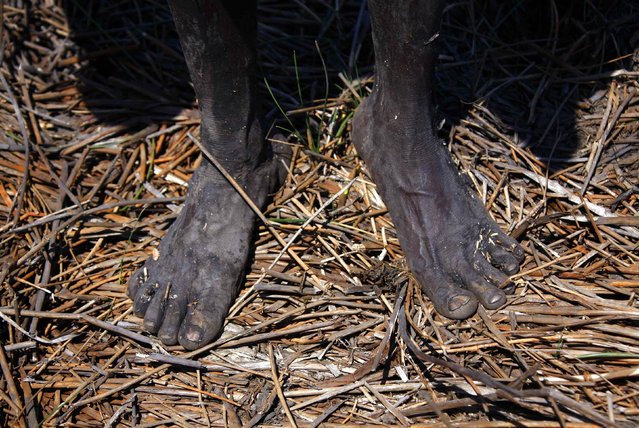
The bare feet of Australian Aboriginal hunter Robert Gaykamangu of the Yolngu people can be seen as he stands next to a billabong near the “out station” of Ngangalala, on the outksirts of the community of Ramingining in East Arnhem Land November 23, 2014. (Photo by David Gray/Reuters)
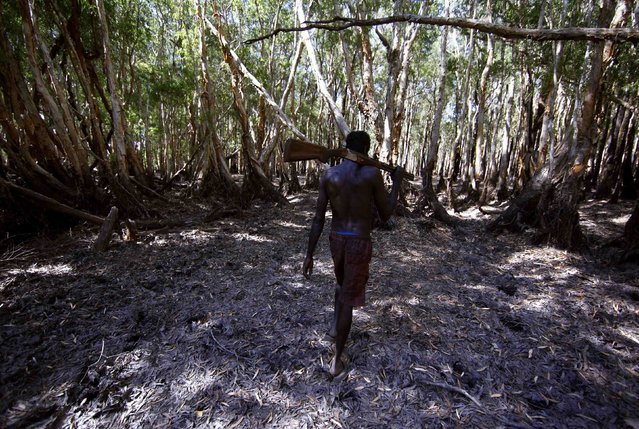
Australian Aboriginal hunter Roy Gaykamangu of the Yolngu people carries a shotgun over his shoulder as he walks through a native paperbark tree forest near the “out station” of Yathalamarra, located on the outksirts of the community of Ramingining in East Arnhem Land November 22, 2014. (Photo by David Gray/Reuters)

Australian Aboriginal hunter Michael Gaykamangu of the Yolngu people carries his three-year-old son Johnny on his shoulders as they walk through a paperbark tree forest to look for crocodiles at a billabong near the “out station” of Yathalamarra, located on the outksirts of the community of Ramingining in East Arnhem Land November 22, 2014. (Photo by David Gray/Reuters)
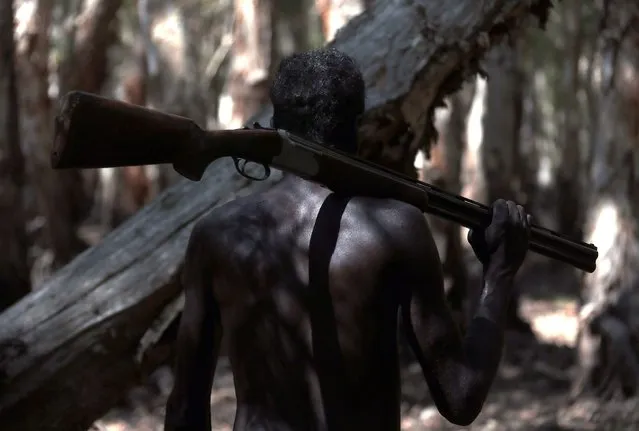
Australian Aboriginal hunter Roy Gaykamangu of the Yolngu people carries a shotgun over his shoulder as he walks through a native paperbark tree forest near the “out station” of Yathalamarra, located on the outksirts of the community of Ramingining in East Arnhem Land November 22, 2014. (Photo by David Gray/Reuters)
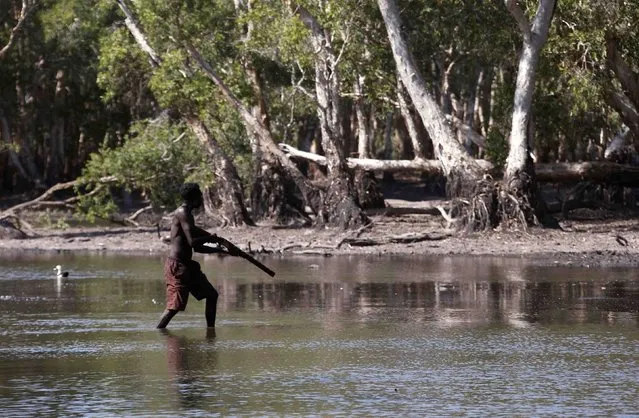
Australian Aboriginal hunter Roy Gaykamangu of the Yolngu people walks across a billabong while hunting a crocodile near the “out station” of Yathalamarra, located on the outksirts of the community of Ramingining in East Arnhem Land November 22, 2014. (Photo by David Gray/Reuters)
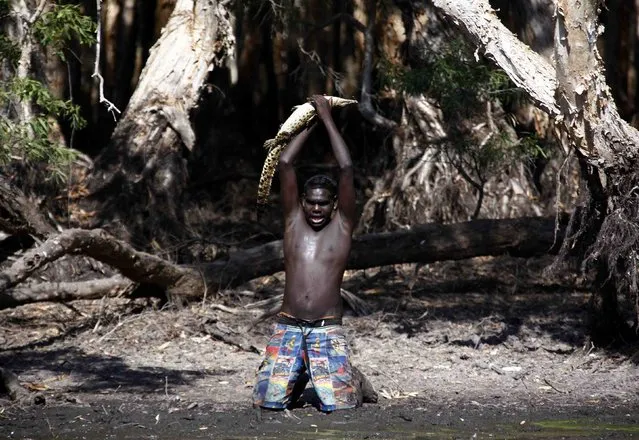
Australian Aboriginal hunter Marcus Gaykamangu of the Yolngu people lifts a baby crocodile above his head after capturing it at a billabong near the “out station” of Yathalamarra located on the outksirts of the community of Ramingining in East Arnhem Land November 22, 2014. (Photo by David Gray/Reuters)
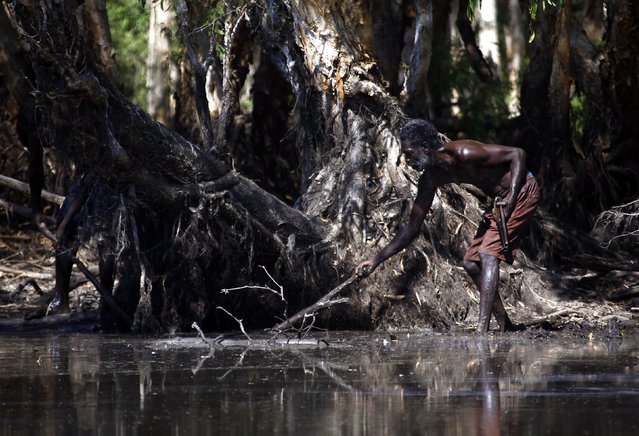
Australian Aboriginal hunter Roy Gaykamangu of the Yolngu people uses a stick to try and find a crocodile he is hunting in a billabong near the “out station” of Yathalamarra, located on the outksirts of the community of Ramingining in East Arnhem Land November 22, 2014. (Photo by David Gray/Reuters)

Australian Aboriginal hunter Roy Gaykamangu of the Yolngu people stands in a billabong after shooting a crocodile near the “out station” of Yathalamarra, located on the outksirts of the community of Ramingining in East Arnhem Land November 22, 2014. (Photo by David Gray/Reuters)

Australian Aboriginal hunter Roy Gaykamangu of the Yolngu people drags a crocodile he has just shot dead out of a billabong near the “out station” of Yathalamarra, located on the outksirts of the community of Ramingining in East Arnhem Land November 22, 2014. (Photo by David Gray/Reuters)
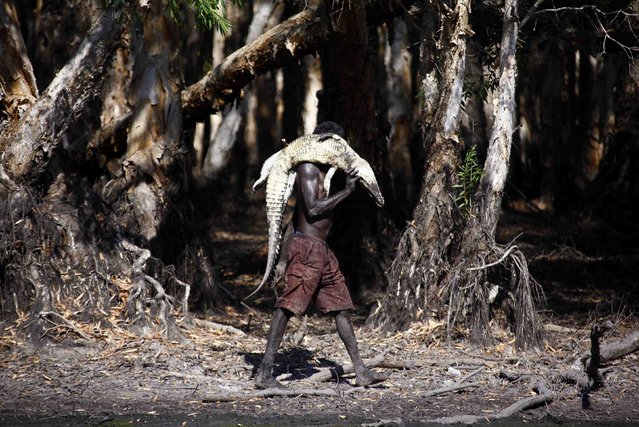
Australian Aboriginal hunter Roy Gaykamangu of the Yolngu people carries a crocodile he has just shot dead along the edge of a billabong near the “out station” of Yathalamarra, located on the outksirts of the community of Ramingining in East Arnhem Land November 22, 2014. (Photo by David Gray/Reuters)
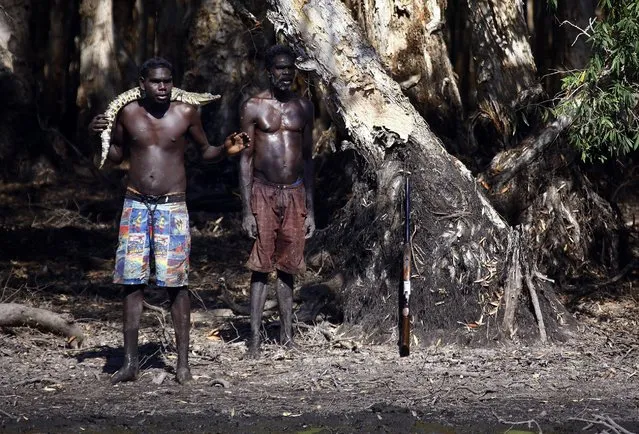
Australian Aboriginal hunter Roy Gaykamangu of the Yolngu people, stands with his son Marcus who carries a baby crocodile on his shoulders on the edge of a billabong near the “out station” of Yathalamarra, located on the outksirts of the community of Ramingining in East Arnhem Land November 22, 2014. (Photo by David Gray/Reuters)
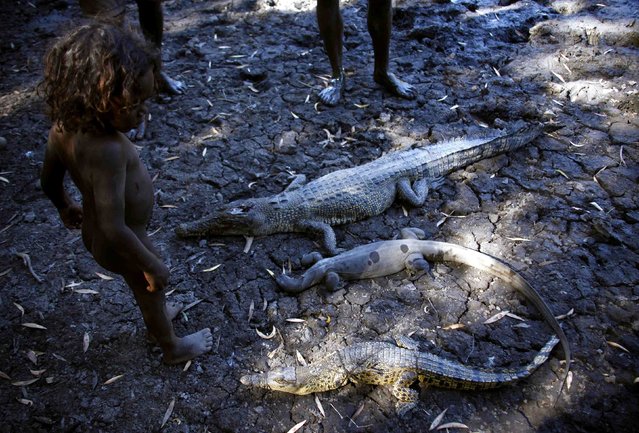
Johnny, the three-year-old grandson of Australian Aboriginal hunter Roy Gaykamangu, of the Yolngu people looks at the crocodiles and a native Australian lizard called a Goanna that have been killed at a billabong near the “out station” of Yathalamarra, located on the outksirts of the community of Ramingining in East Arnhem Land November 22, 2014. (Photo by David Gray/Reuters)
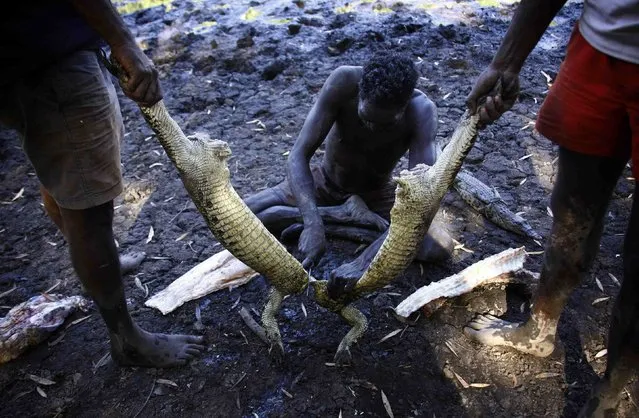
Australian Aboriginal hunter Roy Gaykamangu of the Yolngu people sits by a billabong and cuts up a crocodile he just shot dead near the “out station” of Yathalamarra, located on the outksirts of the community of Ramingining in East Arnhem Land November 22, 2014. (Photo by David Gray/Reuters)
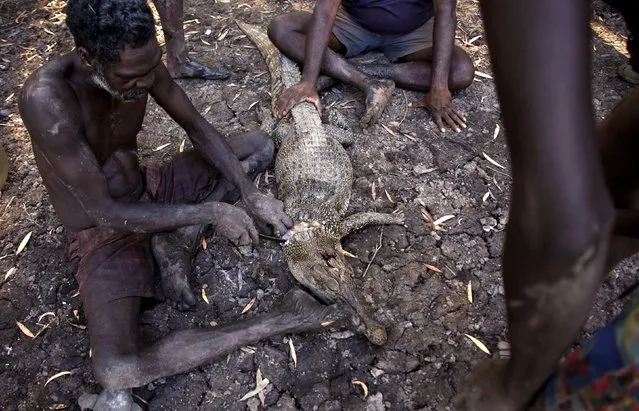
Australian Aboriginal hunter Roy Gaykamangu of the Yolngu people sits by a billabong and cuts up a crocodile he just shot dead near the “out station” of Yathalamarra, located on the outksirts of the community of Ramingining in East Arnhem Land November 22, 2014. (Photo by David Gray/Reuters)
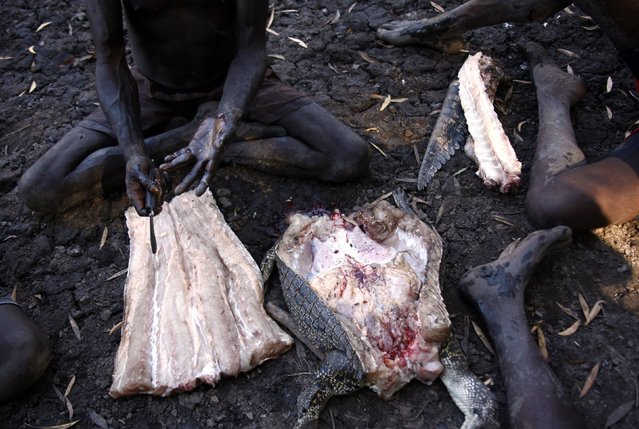
Australian Aboriginal hunter Roy Gaykamangu of the Yolngu people sits by a billabong and cuts up a crocodile he just shot dead near the “out station” of Yathalamarra, located on the outksirts of the community of Ramingining in East Arnhem Land November 22, 2014. (Photo by David Gray/Reuters)
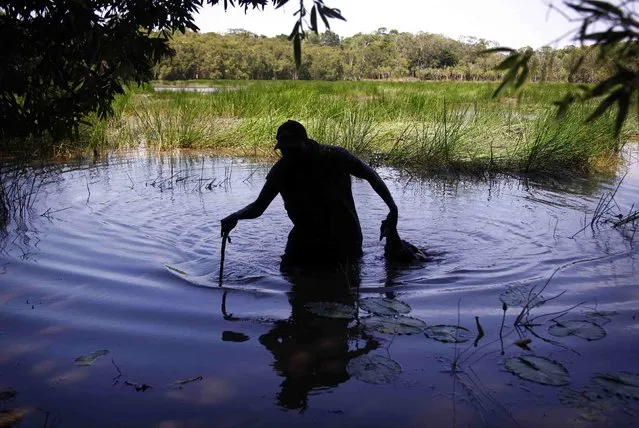
Australian Aboriginal hunter Robert Gaykamangu, of the Yolngu people, carries a Magpie Goose he successfully shot as he wades through a billabong near the “out station” of Ngangalala, located on the outksirts of the community of Ramingining in East Arnhem Land November 25, 2014. (Photo by David Gray/Reuters)
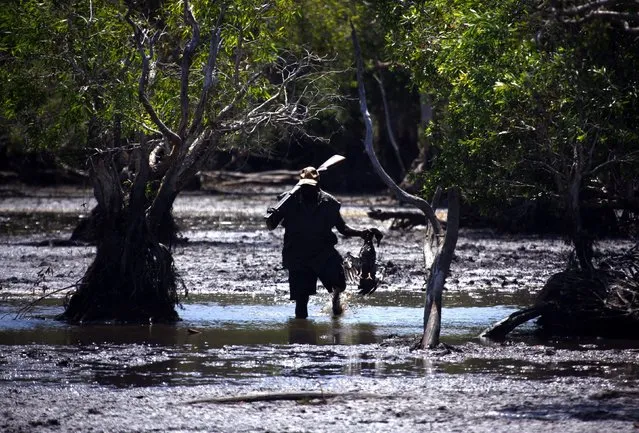
Australian Aboriginal hunter Robert Gaykamangu of the Yolngu people carries a Magpie Goose he successfully shot in a billabong near the “out station” of Ngangalala, located on the outksirts of the community of Ramingining in East Arnhem Land November 23, 2014. (Photo by David Gray/Reuters)
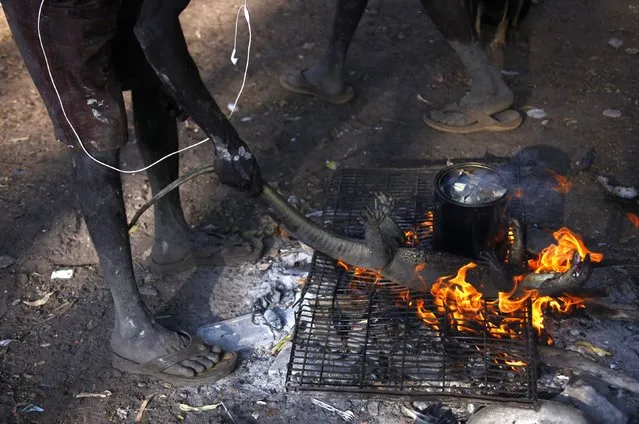
Australian Aboriginal hunter Roy Gaykamangu of the Yolngu people places a native Australian lizard called a Goanna on a fire to cook it at the “out station” of Yathalamarra, located on the outksirts of the community of Ramingining in East Arnhem Land November 22, 2014. (Photo by David Gray/Reuters)

Australian Aboriginal hunters Bruce and Robert Gaykamangu of the Yolngu people cook a Magpie Goose they just shot near the “out station” of Ngangalala, located on the outksirts of the community of Ramingining in East Arnhem Land November 25, 2014. (Photo by David Gray/Reuters)
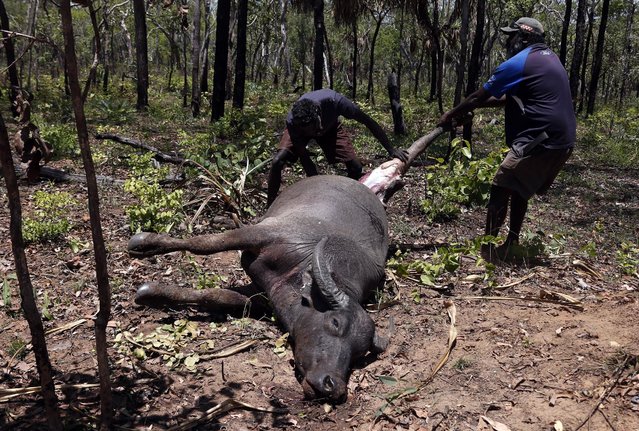
Australian Aboriginal Norman Daymirringu (R) and friend James Gengi of the Yolngu people cut off the leg of a buffalo for food after they discovered it dead on the side of a dirt track on the outskirts of Ramingining in East Arnhem Land November 21, 2014. (Photo by David Gray/Reuters)
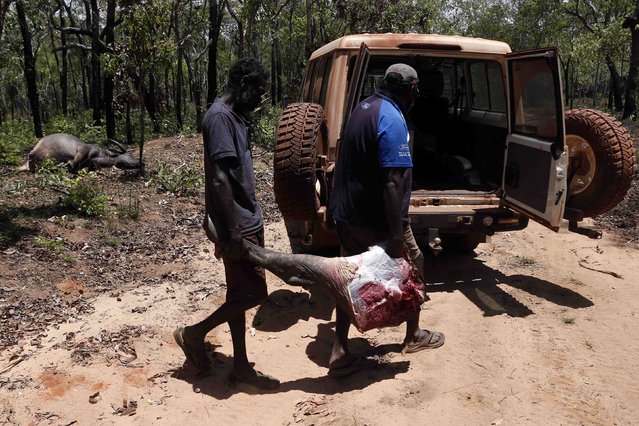
Australian Aboriginal Norman Daymirringu (R) and friend James Gengi of the Yolngu people load the leg of a buffalo, which they intend to cook, into their vehicle after they discovered it dead on the side of a dirt track on the outskirts of Ramingining in East Arnhem Land November 21, 2014. (Photo by David Gray/Reuters)
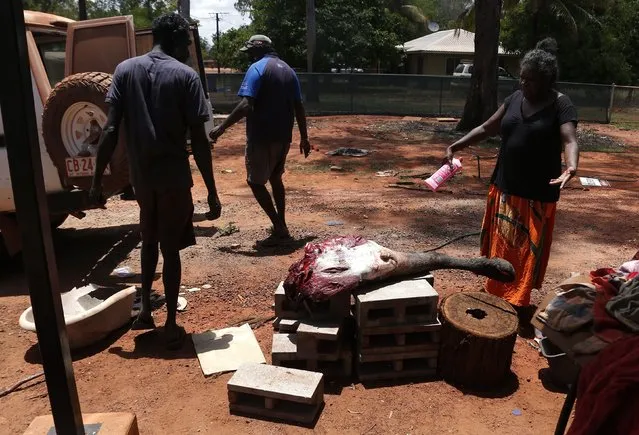
Australian Aboriginal Norman Daymirringu (C) and friend James Gengi (L) of the Yolngu people deliver a leg of a buffalo to a member of the community after they cut if off a dead buffalo on the side of a dirt track on the outskirts of Ramingining in East Arnhem Land November 21, 2014. (Photo by David Gray/Reuters)
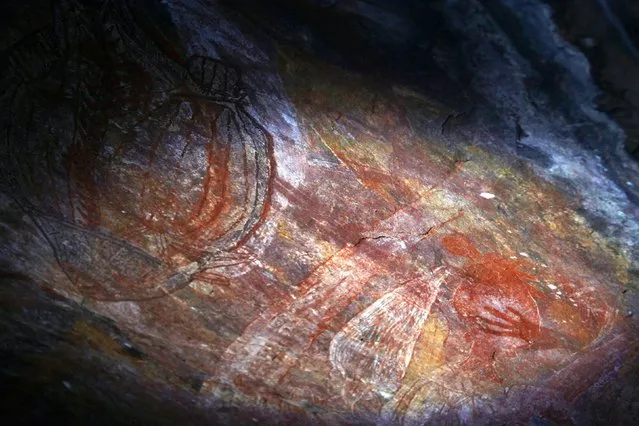
Australian Aboriginal rock art can be seen in a cave near the township of Jabiru located near Arnhem Land November 26, 2014. (Photo by David Gray/Reuters)
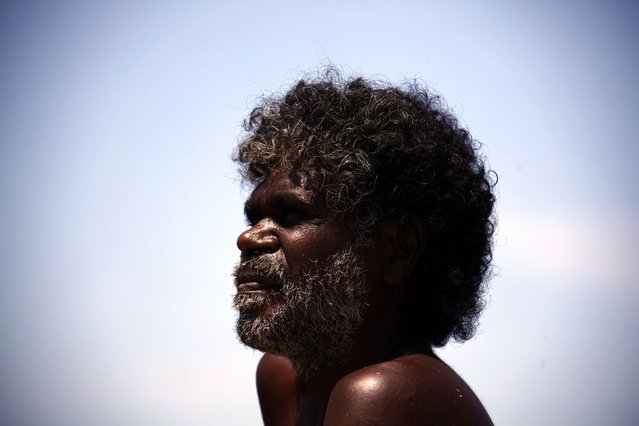
Australian Aboriginal hunter Bruce Gaykamangu of the Yolngu people looks across a billabong at potential prey near the “out station” of Ngangalala, located on the outksirts of the community of Ramingining in East Arnhem Land November 25, 2014. (Photo by David Gray/Reuters)
11 Dec 2014 13:19:00,
post received
0 comments
